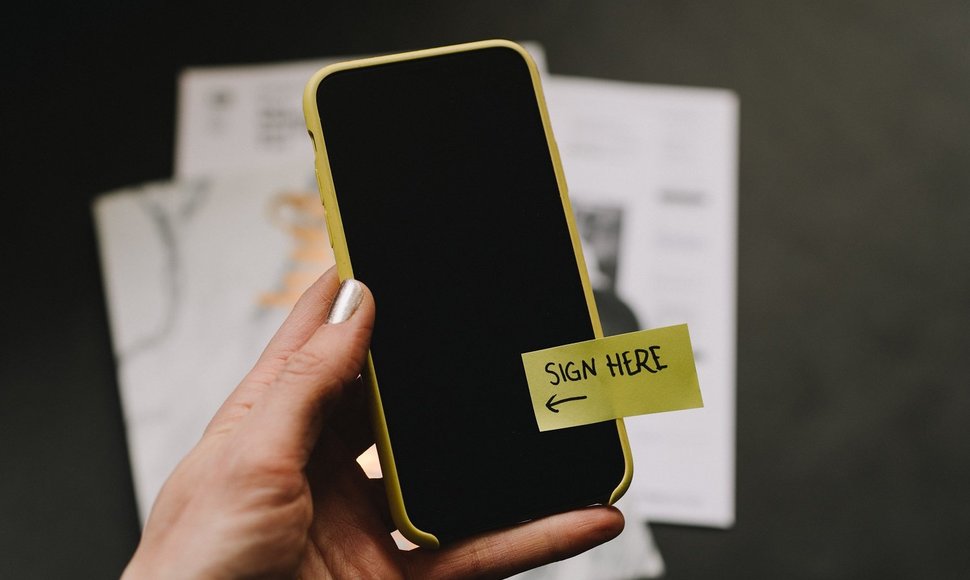An e-signature is universally applied for signing documents and verifying your identity. Today, these functions have expanded even further: e-signatures can now be used to sign housing lease contracts or rent tools. They are also used by doctors in medical institutions for signing treatment results or encoding test results, as well as some educational institutions for signing diplomas. E-signatures are used by various governmental and non-governmental institutions for managing the processes of digitising the economy.
E-signature alternatives
Ričardas Servetka, Director of the Centre of Information Technology of Mykolas Romeris University (MRU), says that the e-signature system has been implemented and is widely used in the university, but there is also the human factor: "We are moving into the digital space, digitising our documents and processes, and have also implemented the e-signature. However, it is obvious that our community is inert and accustomed to the previously established processes. More time is needed for it to be able to consciously shift into the digital space and develop new habits."
MRU has been using a qualified e-signature for more than eight years now. Preparation and coordination of draft documents and signing of documents with a qualified e-signature are performed using qualified certificates issued by the Centre of Registers via cryptographic USB storage media. In 2020, the university used the Smart-ID authentication tool to manage the risk of various technical and communication disruptions as well as to have an alternative.
Smart-ID is an official certified means of authentication and a qualified electronic signature. According to Viktoras Kamarevcevas, head of SK ID Solutions in Lithuania, a company that created this tool, Smart-ID is already used by more than 1.3 million people in Lithuania alone. Smart-ID can be used on all smart devices such as phones and tablets, all you need is a wireless or mobile internet connection. In this case, you do not need roaming connection or a special SIM card which are required to use a mobile signature issued by telecommunications companies.
Legal aspects and validity of an electronic signature
The legal effect of a qualified e-signature is the same as that of a traditional handwritten signature. It must be verified by a qualified certificate which links the e-signature verification data to a specific natural person, verifying his or her name and surname. The electronic certificate is drawn up by a qualified trust service provider, its security is being strengthened every year, and no one else can use the signature in place of the specified person.
A certified electronic signature is recognised throughout the European Union. Experts point out that when signing documents in the digital space, it is necessary to take into account the format of the document – it must be signed in the format in which the document is received. The most popular official formats in different countries are ADOC, PDF, EDOC and ASiCE. PDF is a universally recognised format commonly used in the Lithuanian business environment, whereas the public sector usually uses the ADOC format.
Time stamps can also be added to documents when signing them. This is factual proof that the document was signed before the time indicated on the time stamp and during the validity period of the electronic signature certificate.
Digitisation process in Lithuania
Natalija Jonušienė, CEO of document and process management system DocLogix and business process management specialist, assures that electronic signatures and digital space can significantly simplify the signing and storage of documents and ensure efficient management of the company's processes.
Digital space eliminates distances as well as saves time and money. In the past, all state and non-state institutions stored their documents in archives. Today they are slowly shifting into the digital space. Qualified and non-qualified e-signature solutions integrated into the document and process management system are designed to manage risks in the event that one or another method of signing does not work. In addition, in the widely applicable system, electronic documents are retained for a set period of time.
"A qualified signature is the functionality and uniqueness of a product. Typically, documents in the system are signed with certified electronic signatures accompanied by a time stamp. For the convenience of our clients, the system allows signing in two ways: by either using a mobile signature or Smart-ID. An additional time stamp is also added automatically to keep the signature and documents valid and protected. It is a useful tool on the road toward digitisation," says N. Jonušienė.
According to the data of the European Commission, Lithuania ranks 14th in the 2020 Digital Economy and Society Index (DESI). This index measures Europe's overall digital performance and the progress of EU countries in the field of digital competitiveness. The report points out that the integration of digital technologies and digital public services has been particularly successful over the past year.













